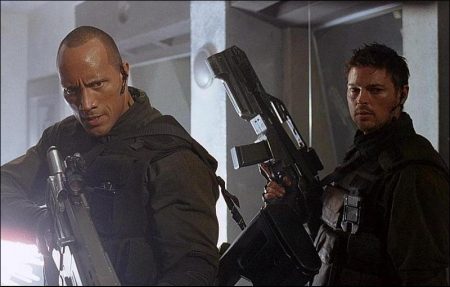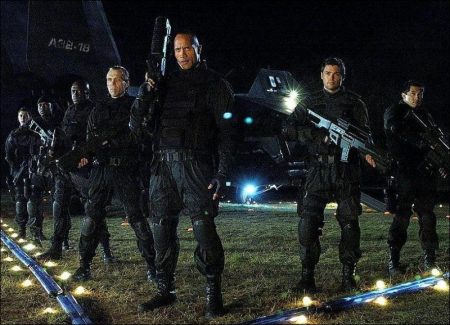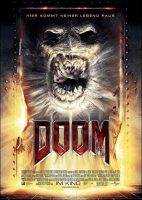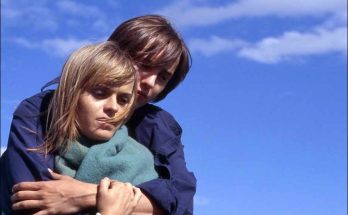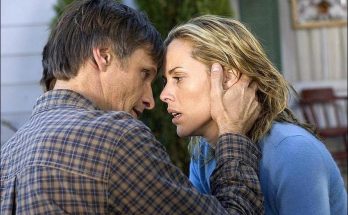Tagline: Hell Breaks Loose.
Doom, the landmark videogame that electrified a generation, leaps from the computer screen to the big screen as a terrifying sci-fi horror action adventure, transporting audiences to a dark and disturbing future with all the visceral excitement and horror that made its gaming predecessor a global phenomenon.
The action takes place at Olduvai Research Station, a remote scientific facility on Mars, where something has gone terribly wrong. All experiments have ceased, and communication has failed. The few messages that do get through are less than comforting.
It’s Level 5 Quarantine, and the only souls allowed in or out are the Rapid Response Tactical Squad (RRTS)-hardened Marines armed to the teeth with enough firepower to neutralize any enemy… or so they think. The researchers at this Red Planet station have unwittingly opened a door, and all hell has broken loose. A legion of nightmarish creatures of unknown origin lurks in every corner and stalks the countless rooms of the facility.
A hellish zoo of demons, Imps, Barons and Hell Knights has taken over Olduvai. And they’re not giving it back without a fight. Sealing off the portal to Earth, Sarge (The Scorpion King’s Dwayne “The Rock” Johnson), Reaper (The Lord of the Rings’ Karl Urban) and their mercenary team must use every weapon at their disposal-and some they find along the way-to carry out their orders: nothing gets out alive. Unfortunately, these things never go as planned…
“Doom”: History of the Game
“This is one hell of a ride.” – Computer Gaming World
On December 10, 1993, id Software-a small company in Mesquite, Texas-un- leashed a groundbreaking “Doom” on the world. A technically stunning feast of heart-stopping action and unspeakable horror, “Doom” heralded a paradigm shift in video games-the dawn of the FPS (“First Person Shooter”) perspective, in which gamers explore the map and annihilate enemies through the eyes of their on-screen avatars. “Doom” introduced multiplayer gaming over networks; file shareware (free demo-level downloads of the game); and a system that encouraged users to modify and create their own levels. Selling millions of copies and racking up tens of millions of shareware downloads, countless industry awards and critical accolades, “Doom” remains one of the most popular PC games of all time.
In October 1994, id Software introduced a sequel, titled “Doom II: Hell on Earth,” followed by the additional titles “Final Doom” and “Ultimate Doom,” the first “Doom” game available at retail outlets.
“Doom3” went into development in 2000 and was released in August 2004. With a revolutionary graphics engine and intense, atmospheric visuals, it took the “Doom” experience to a new level of suspense and visceral excitement. In just five short months “Doom3” sold over a million copies for PC-with a Microsoft Xbox version and PC Expansion Pack, “Resurrection of Evil,” following shortly thereafter.
Now the game that made history makes its way from the computer monitor to the big screen as a thrilling science-fiction horror action adventure. As avid gamers and “Doom” fans themselves, producers Lorenzo di Bonaventura and John Wells were committed to creating a unique cinematic experience that held true to the feel and spirit of the game. “The most important thing was to be true to the essence and the core of it,” says di Bonaventura. “But the real challenge was to try with a story that non-gamers would appreciate just as much.”
“The game itself is very cinematic and very scary,” comments Wells. “You enter this world in a subjective manner, in the first person, and walk through these corridors and around corners, where terrifying demons can jump out at you at any second. Even though it’s a computer screen in front of you, the best way to play `Doom’ is to turn the lights down low, close the curtains and scare yourself half to death. Both Lorenzo and I thought that would translate very well into a film.”
With the game series as the basis for the film, di Bonaventura and Wells brought together a group of the property gatekeepers who could bring the world of “Doom” to life as it never had been before-beginning with id Software CEO Todd Hollenshead and the game’s architects John Carmack, Kevin Cloud and Tim Willits.
“We looked to id to be our guide,” di Bonaventura recalls.
“We weren’t looking for the film to be exactly the type of story we had,” id’s Hollenshead adds. “We wanted the movie to have something that was new, that would be interesting and exciting to fans-with a bit of the unexpected in there-but still be true to the feel of playing the videogame.”
From Virtual Space to the Big Screen
Undoubtedly, bringing a film with Doom’s history and scope to life required a director that could marry a fleshed-out drama and visual experience with the visceral excitement of the game. Lorenzo di Bonaventura had previously worked with Andrzej Bartkowiak on the martial arts movies Romeo Must Die, Exit Wounds and Cradle 2 the Grave and felt Bartkowiak’s vision for Doom was ideal. He knew the director had a strong, fast and collaborative work ethic-mandatory for an undertaking of this nature.
“Before he was a director, Andrzej was one of the greatest cinematographers that ever lived,” says di Bonaventura. “I knew he could bring tremendous scale to the movie.” Screenwriters David Callaham and Wesley Strick set out to write a stand-alone film with solid foundation in the gaming experience. “The setting is the same, yet more complicated, and the world we move through is very similar,” notes Wells. “We kept some of the game’s most iconic elements. At the same time, you don’t have to have played the game to understand this world and be scared.”
Doom’s ensemble cast is led by Dwayne “The Rock” Johnson, who has been a fan of “Doom” since its first incarnation. “It broke the mold,” he says. “You are, for the first time in the history of video gaming, the `first person’ shooting. You are this person walking through this incredible world, shooting these monsters.”
Though he was originally approached to portray the hero of the piece, Johnson dove straight into the concept of playing its antihero-Sarge, the uncompromising Marine sergeant whose zeal for orders skates the edge between enforced morality and pure evil. “This film pulls no punches,” he says. “We are unapologetic in portraying this world and this story.”
“All of us were thrilled when Dwayne wanted to play Sarge,” says di Bonaventura. “He is immensely talented and has a natural command of a room that comes in handy if you’re commanding a platoon.”
To play Reaper, the soldier at the heart of the adventure, the filmmakers needed a leading man who could carry out nonstop mayhem while bringing emotional depth and conflict to the character.
Karl Urban, who rose to prominence playing Eomer in The Lord of the Rings trilogy, had also been a fan of the game. “The opportunity to have my own 3-D version of it, and to play it out, was a no-brainer for me,” Urban remarks. “It was a very solid script with fantastic, three-dimensional characters, all with great arcs and journeys. Most importantly, it was a faithful rendition of the game. It’s unapologetic. It’s dark and intense.”
Sarge’s team is comprised of `an eclectic ensemble of actors from the U.S. and the U.K.-many of whom are classically trained theater actors: DeObia Oparei as Destroyer, Ben Daniels as Goat, Raz Adoti as Duke, Richard Brake as Portman, Yao Chin as Mac and Al Weaver as The Kid lend their talents to complete the RRTS. Rosamund Pike and Dexter Fletcher round out the cast as the brilliant scientist Dr. Sam Grimm-Reaper’s sister-and Pinky, the paraplegic communications officer.
Like Johnson and Urban, many of the core cast had played “Doom.” “It’s a massive game, and it’s got a massive fan base,” notes Adoti. “You want to do it justice.” Daniels had played the game since it was first introduced. “When I read the script, I knew that the people who had written it are gamers,” he comments. “No one but a gamer would have written a `First Person Shooter’ sequence in a game-to-movie conversion.”
The great challenge for the visual effects department was to create the film’s groundbreaking “First Person Shooter” sequence that unfolds through Reaper’s perspective. It’s an all-out search-and-destroy mission in which Reaper takes on numerous creatures that have never before been seen in any of the “Doom” games.
The filmmakers wanted to give the audience the same thrill that they found in the “Doom” game series. Military fatigues at the ready, weapons gripped tightly in hand, the audience would become the Marines of the film.
“`First Person Shooter’ is a tip of the hat to the gamers,” di Bonaventura describes, “but it’s also just a plain exciting concept-a way to convey the heightened reality of what’s happening. I think that section is where people who don’t play games will completely understand why gamers do it.”
“It just brings you right into the action,” says Adoti. “It grabs you by the collar and brings you in. You can’t just be comfortable in your seat watching it with your popcorn. You’re involved with it suddenly, and it’s very real.”
Becoming a Marine on Mars
Weeks prior to the start of production, the cast and filmmakers descended on Barrandov Studios in Prague, Czech Republic. As sets were being designed and constructed, the men in the cast began an intensive training period to gel into the cohesive military unit they portray in the film.
Though Doom takes place in a futuristic society on a distant planet, the cast and filmmakers dedicated themselves to achieving palpable realism throughout every aspect of the production. To portray elite soldiers, the core cast would need to learn everything about how a soldier acts, moves and speaks.
This challenge fell to consultant Tom McAdams, who had spent almost three decades serving in the military. McAdams joined the company to take the actors through an abbreviated but intensive two-week-long “boot camp.” This included courses in weaponry, ammunitions, first aid and communications. McAdams trained the core team with Kalashnikov blank-round-firing AK-47s, though they would all carry different weapons in the film.
“I formulated a basic program, which started with familiarization of weapons systems-strip and assembling, hold and aiming, stoppage drills, loading, unloading-all the things that a basic soldier would have to know,” McAdams explains. “Even though some of the actors have used weapons previously in films, they didn’t have the depth of knowledge that I wanted to give them. When they picked up the weapon, they had to handle it correctly. Everything they did needed to look exactly how Special Forces would do it…like they’ve had years of experience soldiering.”
“If we’re going to be Special Forces, then we should spend a lot of time together,” says Johnson. “I’ve got a lot of respect for our soldiers, so I was really excited to do this.” Adds Urban, “Not only did Tom instill in us the kind of military knowledge and skills we needed, but he also helped us bond and form into a solid, cohesive unit.”
“We got up every morning at 6 a.m. and trained together,” Johnson remembers. “Tom was invaluable to the group. He answered every single question that was possibly asked of him.”
Though he was initially charged with only boot camp, everyone in front of and behind the camera saw value in retaining McAdams for his unique point of view on the film’s military actions throughout production. His notes resulted in significant changes to the script to bridge the gap between fantasy science fiction and military reality.
McAdams, who had never previously consulted on a film production, was surprised by how serious and focused the actors were about their weapons training. “Even in their time off, some evenings we’d stay behind another two hours or so after filming, just so the guys could do their drills again and have continuity,” McAdams recalls.
Director Bartkowiak also consulted with McAdams before each set-up to ensure the action (as he had blocked it) passed muster with the military expert. “Before any scene, we’d always get together first thing and do a walk-through, then bring the actors in and explain to them who would go in and who would give covering fire,” McAdams explains.
The men constituting the RRTS were not the only ones to undergo training upon their arrival in Prague. Throughout her life, Rosamund Pike, who portrays scientist Sam Grimm, has had a fascination for all things medical and relished the opportunity to attend Prague Medical School for some dissection and anatomy classes. “I worked with a paramedic and joined the second-year medics in their human dissection classes,” she says. “It’s very full-on…an entire room full of cadavers. I have to have my hands in some pretty dank and nasty places in the film,” Pike says.
Using Big Weapons to Fight Big Monsters
McAdams also worked with production designer Stephen Scott, armorer Richard Hooper and prop master Ray Perry on the handling of the production’s numerous weapons. Hooper had made conceptual drawings of modifications to present-day weapons, guided by the principles that the film was set sometime in the future. For all intents and purposes, the weapons would need to be fully functional for the actors to use on-camera. This idea was to make “some of the biggest guns ever produced,” says production designer Scott.
The team also wanted each character to be identifiable through his weapons. “You get to know the characters by their guns, so we tried to make the weapon unique for each person,” says Hooper.
In keeping with the spirit of the “Doom” series, the characters’ weapons are true to form. Reaper carries a standard combat weapon with a rifle inside the outer casing. Sarge carries a bigger and more powerful gun. Destroyer has the largest of the weapons-a chain gun, with ammunition fed in from a pouch on his back. Goat carries a pump-action shotgun. Duke and Portman are armed with plasma rifles that have powerful torches and cameras, and The Kid carries handheld submachine guns.
“Most of the actors preferred to hang on to their weapons during breaks rather than put them down,” Hooper observes. “They carried it or slung it around their shoulders and the actors forgot about the weight. It became part of them.” The cast often stayed late to clean up their spent shells from the day’s shooting.
Between Hooper and McAdams, gun safety was always an issue, with the actors equally attuned to the dangers of even firing blanks. “We make sure that everybody is protected as much as possible,” says Hooper, “to make sure everybody hits his mark and aims in the right place.”
Throughout the course of the film, Sarge acquires two weapons in addition to his rifle and pistol-Destroyer’s chain gun and the Bio-Force Gun (BFG). The chain gun was by far the loudest and most impressive to Johnson. “When you fire that thing, it gives you an amazing feeling of power,” he says, “even with 50 zombies coming at you.”
One of the hallmarks of the game was sure to be included in Doom’s feature film debut. The BFG was an element that had to carry over. “It’s suspended in air, just like in the videogame. As Sarge takes it off, the first words out of his mouth are `Oh s—-,’” laughs Johnson.
Its early designs rendered it too bulky and heavy to create as an actual firing weapon. So Hooper and visual effects supervisor Jon Farhat collaborated on creating something that would be visually convincing through digital effects. “The BFG is the `holy grail’ of the weapons within the Weapons Lab on the planet,” says Hooper.
Dreaming up Demons from Hell
The game, `Doom,’ features a legion of Imps, zombies, demons and other monstrosities that had all been created digitally by id Software’s John Carmack, Kevin Cloud, Tim Willits, Kenneth Scott and other designers and artists. For the film, director Bartkowiak and producers di Bonaventura and Wells would settle for nothing less than horrifically tangible, physical creatures. “With our resources, we had to push them a little bit further and allow them to be even more articulated than they are in the game,” comments di Bonaventura.
For this critical element, they turned to Stan Winston Studio, which has created legendary cinematic creatures from the xenomorphs of Aliens to the hunter Predator and the unstoppable Terminator.
To ensure continuity of the creatures from the game, the team at id Software sent the high-poly and matte models of the various demons-including the Hell Knights, Imps, Pinky Demon and the Imp-over to special makeup effects supervisor John Rosengrant and visual effects supervisor Jon Farhat.
To perform as the hero creatures, Stan Winston Studio called on 6’4” Doug Jones and 6’8” Brian Steele. Jones, who previously played the aquatic Abe Sapien in Hellboy recalls, “I saw designs of the monsters from the game, creatures with spiky shoulders that throw fire and crawl up walls and I thought, `Oh yes, that’s something I could do.’” Jones also coached the dancers Bartkowiak brought in from Prague to perform as zombies and in crowd scenes.
Jones had created body molds for previous films, so as soon as he signed on, Rosengrant and his team began to create latex bodysuits of the various creatures he would play. “I play all the Imps in the film,” he says. “I die about four different times.” For scenes in which a demon would be slain by bullets, special effects supervisor Kit West fitted the suits with explosive squibs over thick body armor that would protect him from each bullet impact. These, along with the jaws and other servo-motor parts on the creatures’ surfaces, were controlled by Rosengrant’s on-set technicians.
“These monsters are the real deal,” says Johnson. “They look incredible, with sheer gravity and weight. They really kick a lot of ass in the movie.”
“You can feel the texture of all these creatures,” says Pike. “They’re all so functional and real and terrifying. It does feel like you’re in a videogame.”
Ben Daniels describes the sequence when the Imp sinks its teeth into him as “deeply freaky. The motor on the jaws was really strong and the teeth are made from the actual material that dentures are made from. I had nightmares for weeks.”
Combat Ready: The Creatures of Doom Attack
The demons had several extended combat sequences that required collaboration between many departments-from West’s special effects group to Rosengrant’s makeup effects crew to the actors themselves. Designing these fights fell to Hong Kong fight choreographer Dion Lam. A veteran of numerous films (including the Matrix trilogy), Lam examined the strengths and weaknesses of the players, as well as the locations where the fights would take place, to add organic elements to each fight. He then storyboarded and shot each scene using members of his own team.
The first scene-a mammoth battle between Destroyer (DeObia Oparei) and the Hell Knight, a towering demon locked in an electrified metal holding cell, marked Lam’s first experience choreographing a fight in which one of the fighters was wearing a suit. “I designed a fight with two beings, one of which had tremendous power and the other was only human,” Lam says. “Destroyer is confronted with this huge creature that is bent on killing him. He punches him; it doesn’t work. Head-butt, kick; totally doesn’t work. So…he has to use his imagination.”
Working with the director and West, Lam used the set to dictate how the fight would play out. “Every time one of the combatants gets thrown against the fence, he is electrocuted,” explains special effects supervisor West. West dressed his team in black costumes against black backgrounds and applied welding rods at the end of sticks that would send sparks in all directions each time a body hit the mesh wall. “It was absolute mayhem,” he remembers.
Lam’s second major fight sequence was between Sarge and John, both of whom are, by the end of the film, physically enhanced. “The Rock is a big man,” says Lam. “But Karl is very strong and quick. Both characters are smart Marines with a military background, and that includes a certain amount of martial arts.”
To portray their increased strength, Lam put the actors on wires to allow them to execute high leaps and falls. To ground the film in realism spliced with science fiction, he avoided the more whimsical wirework that can be used in martial arts films.
Visual effects supervisor Jon Farhat and his team enhanced West and Rosengrant’s physical on-set work. They also created additional futuristic touches, such as the team’s transportation through the Arc Chamber wormhole and Pinky’s digital wheelchair device. Dexter Fletcher, who plays Pinky in the film, flew to Prague early in the prep stage to be fitted with a special wheelchair rig. Later, this rig would be replaced by a digital model that would appear welded to his character’s severed body.
The Look of Horror: Martian Sets
To physically realize the underground research station already familiar to players of the game, the filmmakers brought in two-time Academy Award-nominated production designer Stephen Scott. Scott studied underground engineering projects and tunneling architecture and technology, but he also analyzed the game itself. “I wanted to take the mood, the atmosphere and some of the scale of the game into the designs of the sets,” he says. “I hope fans of the game will see things they recognize in terms of shapes and technology. Since most of the game is set underground, I wanted that feeling of strength and solidity to carry over. The sets should look heavy, as though they are supporting a million tons of rock and earth above.”
The sets were further enhanced by director of photography Tony Pierce-Roberts’s lighting and photography. “What Tony has done with the lighting is brilliant,” lauds Ben Daniels. “He has recreated the atmosphere from the games with a lot of blue and yellow lighting. Walking through these sets feels like you’re in the game.”
Scott and the construction team built a number of interconnecting sets on soundstages at Barrandov that would give the sense of “dark, tight and narrow spaces”-while allowing for camera and equipment access. Though Scott wanted low ceilings to enhance this effect, he made the ceilings “floating” to allow Bartkowiak to raise or lower his camera to any position in the space. Corridors were also designed to appear different, depending on the angle from which they were shot. “Because it is a dark corridor, if you shoot in one direction it’s a totally different corridor from shooting in the opposite direction,” he says.
To furnish the sets, Scott both extrapolated on present technology and design and looked to the game for inspiration. “I think it’s good to have sets that people can relate to and feel part of,” he says. “The Infirmary contains equipment we have never seen before, yet it feels familiar.”
On Mars, besides the Arc Chamber, there is the Atrium, which in turn leads to the Airlock. Then through the Airlock, the audience is led into the different Laboratory areas-the Animal Lab., the Holding Cell, the Archaeology Lab, the Weapons Lab, Carmack’s Office, the Infirmary, Observation Room, the Bathroom and the Mudroom, which comes off the Archaeological Dig.
For the Atrium set the production used Prague’s Vitkov Mausoleum. It was built in the 1930s with more than a million tons of rock. The color of the floor was changed by laying down a black surface, and further detail-such as Union Aerospace Corporation (UAC) logos and corporate identity symbols-was added.
The rat-infested Sewer runs underneath the corridors. “Tunnels and sewers are a specialty of mine,” says Scott. “They are nice things to design. You can introduce all sorts of very distinct surfaces and textures. We built a sewer, which was around 80 feet long. With a clever bit of shooting and cutting it looks much longer.”
A Helicopter Gun-Ship brings the RRTS from their Barracks on Home Planet to the exterior elevator that takes them to the subterranean Arc Chamber.For this, Scott designed a futuristic-looking helicopter, packed with weapons such as laser-guided rockets.
The team from id Software were the ultimate critics when it came to judging the world Bartkowiak and his core group created in Prague. When Todd Hollenshead and Tim Willits visited the set, they were taken aback. “We’d been working with this game for four years, and suddenly we were stepping out of the game universe in virtual space and onto a live set. Everything, even down to the signs beside the doors and the UAC graphics on the computer monitors, is right down to detail from the game,” remembers Hollenshead.
“The sets give off a tactile sense of jeopardy or concern about what is coming around the corner,” says di Bonaventura. “One of the things that works so well in the game is the sense of claustrophobia. These sets, and the way they were shot for this film, will carry over that palpable sense of impending doom into the theater.”
A Doomed Planet: Background Story
Set in an unspecified future, the story unfolds through the eyes of the RRTS, a highly trained band of Marines led by Sarge, played by Dwayne “The Rock” Johnson. “Sarge is dedicated to America,” says Johnson. “He’s dedicated to the Marine Corps. Above all else, regardless of his orders, he will see that those orders get delivered and will see them through. He has a high amount of respect for his own men, for this elite group of guys that he leads.”
Sarge’s counterpoint is John “Reaper” Grimm, played by Karl Urban. “John Grimm is a complex, introverted character,” notes Urban. “He is the son of scientists who were killed in an accident at Olduvai Station, but he turned his back on the scientific world in favor of the military. He has the nickname of `Reaper.’ That’s partially because of his surname, Grimm, and partially because he’s very good at what he does.”
Supporting Sarge and Reaper is a team of hardened, diverse Marines. “This is a special unit,” describes di Bonaventura. “It’s a tactical squad that has been formed-by the idiosyncratic nature of the characters-to do the really dirty work.” Adds Ben Daniels, who plays Goat, “They’re very good at their jobs, but inevitably when you get a squad that is so specific and highly trained, you get an extreme bunch of people.”
DeObia Oparei (Moulin Rouge!) plays Destroyer, a 6’6,” 260-pound killing machine. “He’s a bad S.O.B.,” describes Johnson. “He carries around this chain gun and he just wants to shoot people.” Theater actor Ben Daniels plays Goat, whom the actor describes as an “obsessive-compulsive who suffers from hyper-religiosity. He’s very peculiar.” Raz Adoti (Resident Evil: Apocalypse) portrays the ladies’ man Duke. “Duke is the epitome of smooth,” Johnson describes. “He’s a player.” Richard Brake (Batman Begins) plays the sinister Portman. “I see him as a scumbag, drug-pedaling bully,” says Brake. “But underneath the surface, he’s just a scared little boy.” And Al Weaver (The Merchant of Venice) comes on board as The Kid, a sharpshooter and the newest member of the team. “This is his first mission with them,” says Weaver. “He’s a good shooter. He knows he can do his job. But he has to grow up, and this mission forces him to do that.” Theater actor Yao Chin plays Mac, who joins the team on its way to Olduvai Station. “Mac is a great piece of the puzzle,” says Johnson.
As the squad is set to take an extended leave, a new mission comes down the chain of command, maintain Level 5 Quarantine on Mars’ Olduvai Research Station-owned and operated by the UAC. “They are going to go on leave when they get called `for a game,’ which tells you a little bit about their mentality,” di Bonaventura comments.
“This is very unfortunate news for the team, but very fortunate news to Sarge, because he lives for this,” adds Johnson.
The RRTS’s rallying call is “Pray for War!” “It’s what they live for,” di Bonaventura says. “Their adrenaline is war. It’s what defines them.”
Wells adds that the expression captures the dichotomy of being in the military-training to commit the very acts one dreads. “It means that we have to confront our fears straight on,” he says. “In the film, it captures the notion that something bad has happened, and they are the people to go and fix it. It’s a challenge-like screaming before you jump off a cliff.”
To get from Earth to Mars, the team must travel through a wormhole-based teleportation system called the Arc, run by wheelchair-bound research casualty Pinky, played by Dexter Fletcher. “In the early days of the Arc and wormhole transportation, the technology had not been perfected and Pinky suffered more than most,” Fletcher explains. “During one transport, things went very wrong and, as one of the characters in the film says, `I went to one planet and my ass to another.’ Consequently, Pinky now has a wheelchair welded to his torso to make him mobile.”
Doom (2005)
Directed by: Andrzej Bartkowiak
Starring: Dwayne Johnson, Karl Urban, Rosamund Pike, Razaaq Adoti, Ben Daniels, Richard Brake, Dexter Fletcher, Robert Russell, Daniel York, Sara Houghton, Ian Hughes
Screenplay by: Wesley Strick, Dave Callaham
Production Design by: Stephen Scott
Cinematography by: Tony Pierce-Roberts
Film Editing by: Derek Brechin
Costume Design by: Carlo Poggioli
Set Decoration by: Richard Roberts
Art Direction by: Peter Francis, Dominic Masters
Music by: Clint Mansell
MPAA Rating: R for strong violence / gore and language.
Distributed by: Universal Pictures
Release Date: October 21, 2005
Views: 97
